
5 Fossil Hotspots: National Parks to Visit
Natlparks Dinosaur
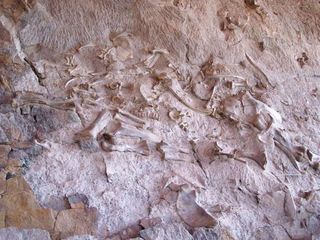
Whether they're the skeleton of a dinosaur or the now stony remains of a tree that lived long ago, fossils can transport us back through the eons, giving us a window into world of the ancient Earth.
Oct. 12 is National Fossil Day in the United States, and many museums and national parks are taking part with special activities and by showing off their fossil collections. Of the nearly 400 national parks and monuments under the National Park Service, some 232 have known fossil resources. Here, we take a look at a few particularly notable fossil hotspots.
Agate Fossil Beds National Monument, Nebraska
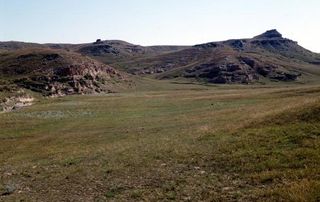
Before western scientists came, the Lakota Sioux knew that this area of what is now Nebraska was rich in the bones of long-extinct animals. In fact, according to the National Park Service, this national monument has one of the world's most complete collections of mammal fossils from the Miocene epoch, which lasted from about 23 million years ago to 5 million years ago.
During this period, areas of what is now North America that had been submerged under ancient seas were drying out and grasslands were proliferating, giving rise to new animals that fed on this abundant food source. The North American rhinoceroses, Menoceras, was a pony-sized animal that had two horns growing side by side on the end of the nose. The Stenomylus camel was a small creature, growing to only 2 feet high, that was more like a tiny antelope. The "ancient beaver" (Palaeocastor) didn't build damns like its modern-day brethren; instead, it dug deep spiral burrows that led to its underground lodges.
The national monument is part of a trail fossil enthusiasts can follow called the "Fossil Freeway" that winds through western Nebraska and South Dakota and hits several fossil hotspots. Visitors centers along the way show the bones and tell the stories of ancient rhinos and mammoths. Some of the other sites the freeway follows are the Mammoth Site of Hot Springs and the Toadstool Geologic Park.
Website: http://www.nps.gov/agfo/index.htm
More Info: 34 miles (55 kilometers) from Mitchell, Neb., in Harrison, Neb., 69346
Phone: (308) 436-9760
Badlands National Park, South Dakota
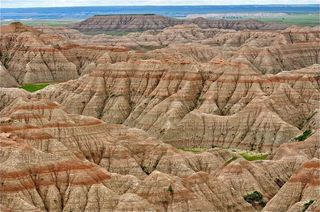
The spectacular vertebrate fossils preserved within the White River Badlands have been studied extensively since 1846, when Dr. Hiram Prout described a titanothere mandible.
The area boasts one of the largest known collections of Eocene (about 56 million to 34 million years ago) and Oligocene (about 34 million to 23 million years ago) mammal fossils. Oligocene fossil remains include camels, three-toed horses, oreodonts, antelope-like animals, rhinoceroses, deer-like mammals, rabbits, beavers, creodonts, land turtles, rodents and birds.
Animals from the Cretaceous Period some 144 million to 65 million years ago are also found in the layers of sediment exposed by erosion in the Badlands. A layer of rock called the Pierre Shale is a treasure trove of Cretaceous fossils, including a wide variety of ammonites and mosassaurs, large extinct marine lizards.
Website: http://www.nps.gov/badl/naturescience/fossils.htm
More Info: 80 miles (130 kilometers) east of Rapid City, S.D., in Interior, S.D., 57750
Phone: (605) 433-5361
Petrified Forest National Park, Arizona
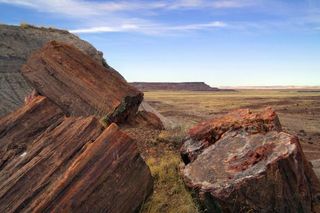
The Petrified Forest is of course most famous for its huge tree fossils. The park has one of the world's largest and most colorful collections of petrified wood.
Petrification is the process by which organic material is converted to stone by the implantation of silica minerals. The trees at Petrified Forest have retained most of their original outer structure, and so still look like trees, but are in fact solid rock.
Petrified Forest also has other plant and animal fossils representing the Late Triassic, going back over 200 million years. The animal fossils range from insects to giant reptiles.
The Triassic Period is sometimes referred to as the "Dawn of the Dinosaurs" because it is the time before the Jurassic Period when dinosaurs were the dominant species on the planet. Dinosaurs fossils are rare here, but the ones that are found are important for the light they shed on this era when dinosaurs, which were much smaller than their later descendents, were just gaining their foothold.
If you come to visit, just make sure to leave things where you found them. The park loses several tons of petrified wood each year to visitors who don't obey these rules.
Website: http://www.nps.gov/pefo/index.htm
More Info: 100 miles east of Flagstaff, Ariz., in Petrified Forest, Ariz., 86028
Phone: (928) 524-6228
John Day Fossil Beds National Monument, Oregon
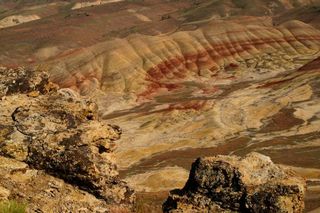
Spectacular geologic features host an abundance of fossils from myriad species at this monument, which is divided into three units.
The Clarno Palisades, west of the town of Fossil, are a striking landform created 44 million years ago by a series of volcanic mudflows called lahars. The Palisades preserve fossils from a time when the region was very different from the near-desert environment that exists today. Tiny four-toed horses, huge rhino-like brontotheres, crocodilians, and meat-eating creodonts roamed the ancient jungles that existed at the time. The fossilized remains of ancient palms and bananas care also found in the rocky towers.
The Sheep Rock Trails take visitors through different geological formations and layers that host a rich variety of fossils, while the stunning Painted Hills display the artistic quality of these layers of time. [8 Amazing National Park Structures ]
Paleontology field work is ongoing at John Day with staff visiting the over 700 fossil sites at the monument in the summer months.
Website: http://www.nps.gov/joda/index.htm
More Info: Kimberly, Ore., 97848
Phone: (541) 987-2333
Dinosaur National Monument, Colorado & Utah

No list of national parks with notable fossils would be complete without Dinosaur National Monument, established in 1915 to protect paleontological resources.
The monument is of course famous for its remarkable cache of dinosaur fossils, which include some world famous specimens: Stegosaurus ungulates, the famous plant-eating dino with plates on its back and spikes on its tail; Diplodocus longus, one of the most abundant sauropods (long-necked dinosaurs) in the Morrison Formation, the layer of rock at the monument where most of the dinosaur fossils are found; and Allosaurus jimmadseni, a carnivore with teeth like serrated steak knives that likely at smaller dinosaurs, among many others. [Image Gallery: Dinosaur Fossils]
Paleontology is still an active science at Dinosaur National Monument; in February 2010, a team of paleontologists announced the discovery of a new, large, plant-eating dinosaur, Abydosaurus mcintoshi, found at the monument.
Visitors can see more than 1,500 fossil bones on display in the newly refurbished Quarry Exhibit Hall, which is specially built to "ride" atop the expanding and contracting layers of clay below.
The Carnegie Museum of Natural History in Pittsburgh also features many dinosaurs on display that were excavated from the Dinosaur National Monument area or have been found here.
Website: http://www.nps.gov/dino/index.htm
More Info: 200 miles (320 kilometers) east of Salt Lake City, Utah, in Dinosaur, Colo., 81610-9724
Phone: (970) 374-3000
Sign up for the Live Science daily newsletter now
Get the world’s most fascinating discoveries delivered straight to your inbox.
